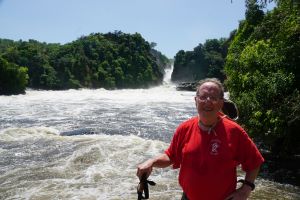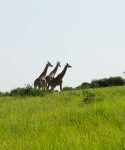Scout Camp on the Equator
May 20,2018
I’m literally in the southern hemisphere, having crossed the equator, in a TENT.

 Crossing the equator resulted in a discovery of a young entrepreneur. Stationed alongside the road, at the equator, is a sign indicating that you are in the middle of the earth. There’s a pull off with shopping opportunities. The owner of stall #8 came over to take my picture with the sign and introduce me to a young man who—for a substantial fee—demonstrated that water does indeed swirl differently north and south—and at the equator, where it drains straight down. Plus, for an additional fee, he signed a certificate verifying that I had indeed been there. As the retail experts say (and it used to be true), the three most important things in retail are “location, location, location.”
Crossing the equator resulted in a discovery of a young entrepreneur. Stationed alongside the road, at the equator, is a sign indicating that you are in the middle of the earth. There’s a pull off with shopping opportunities. The owner of stall #8 came over to take my picture with the sign and introduce me to a young man who—for a substantial fee—demonstrated that water does indeed swirl differently north and south—and at the equator, where it drains straight down. Plus, for an additional fee, he signed a certificate verifying that I had indeed been there. As the retail experts say (and it used to be true), the three most important things in retail are “location, location, location.”
About 10 kilometers east of there (almost on the equator) is the Sweetwaters Tent Camp. But it’s not like the Scout camp we usually attend. There’s concrete floors with carpeting, and an in-tent bathroom and hot shower, along with electricity and wifi (these improvements would 
 definitely benefit Canyon Camp!), with a buffet lunch just after I got here. Right now, I’m looking out at a watering hole where I’ve seen rhinos, water buffalo, and the ubiquitous warthogs. They told me there was a pride of lions last night. In between the two game drives a day, in other words, the animals are invited to come visit us. I’ve issued an invitation, but since it’s Sunday, they must all be in Church said one of the waiters. It’s also a little chilly and overcast.
definitely benefit Canyon Camp!), with a buffet lunch just after I got here. Right now, I’m looking out at a watering hole where I’ve seen rhinos, water buffalo, and the ubiquitous warthogs. They told me there was a pride of lions last night. In between the two game drives a day, in other words, the animals are invited to come visit us. I’ve issued an invitation, but since it’s Sunday, they must all be in Church said one of the waiters. It’s also a little chilly and overcast.
In the distance out my front veranda, is Mt. Kenya, the second highest peak in Africa. The camp is fit for a khan, and, indeed, I learned today that the owner of the camp, and the other hotel in this 90,000 acre game preserve, is none other than Aga Khan.
I knew I was going to like this place when the attendant arrived last night and put two hot water bottles in my bed, which kept me toasty all night. That’s another addition I’d recommend for Scout camp, albeit on cool evenings.
The 90,000 acre preserve offers some really good game drives. On our first drive yesterday, we saw 4 lions in one group, and two in another. That’s the first sightings of a cat I’ve had on this trip. On a night drive yesterday (9-1130), we watched a pair of lions for nearly half an hour. The guide said they pair for four days then find someone else, but these two for most of the time looked like old marrieds, not honeymooners. They couldn’t have been more than 15 feet from us. At night, we also spotted a zebra herd that’s an endangered species.
There’s another endangered species here, the northern black rhino; the only two still in existence—both female—are sequestered in a large, fenced-off area. The ranger-scientists here are hoping the ladies can birth via in vitro; otherwise, assuming I see some today, I will have looked at the last representatives….
The preserve also houses a chimp sanctuary. Having worked hard to see chimpanzees in the wild, I was a little dismayed to be taken to a 250 acre fenced area that housed 39 chimpanzees, until I learned that these were orphaned or injured chimps. One, for example, about 30 years old, walked mostly upright—because he’d spent his first nine years in a small cage in  Abu Dhabi, which gave him no room to play. They really are clever. We watched our guide throw some peanuts (it really was like a zoo, with a big cage!) that the chimp could not reach. He wound up finding a stick which he used to move the peanuts close enough to grab, without touching the electric fence. They are also like fraternity members; they’re cliquish. Newcomers are put in quarantine for 4-6 months before they’re gradually introduced to the group, and still the groups fight if they get together. The chimp area is split by a river, and since chimps don’t swim, the sanctuary can accommodate two groups, one on each side of the river. Even separated, they fight a lot, said the guide, and we could hear them in the bush, as George was contesting power with the current alpha chimpanzee.
Abu Dhabi, which gave him no room to play. They really are clever. We watched our guide throw some peanuts (it really was like a zoo, with a big cage!) that the chimp could not reach. He wound up finding a stick which he used to move the peanuts close enough to grab, without touching the electric fence. They are also like fraternity members; they’re cliquish. Newcomers are put in quarantine for 4-6 months before they’re gradually introduced to the group, and still the groups fight if they get together. The chimp area is split by a river, and since chimps don’t swim, the sanctuary can accommodate two groups, one on each side of the river. Even separated, they fight a lot, said the guide, and we could hear them in the bush, as George was contesting power with the current alpha chimpanzee.
The camp sits in the central highlands, one of the most fertile areas in Kenya, and the home of the Kikuyu, one of some 40 tribes that together constitute the country. Jomo Kenyatta, the first president, was a Kikuyu as is his son, who is or has been President.
Well, I’ve got one more game drive, then an overnight and the long trek back to Central Illinois Regional Airport—3 hours to Nairobi, a midnight  flight to Amsterdam, a flight to Atlanta, and thence home, hopefully
flight to Amsterdam, a flight to Atlanta, and thence home, hopefully  Tuesday. With a little time in Nairobi, I got a chance to visit the home of Karen Blixen, author of “Out of Africa.” I think watching the movie is going to be one of the first things I do when I am acclimated back home again.
Tuesday. With a little time in Nairobi, I got a chance to visit the home of Karen Blixen, author of “Out of Africa.” I think watching the movie is going to be one of the first things I do when I am acclimated back home again.
 By Thursday, however, I bet I could have my bags packed and be ready to “bring on the adventure” again!
By Thursday, however, I bet I could have my bags packed and be ready to “bring on the adventure” again!
I saw some interesting uses of Coca Cola advertising. Churches go better with Coke?


















